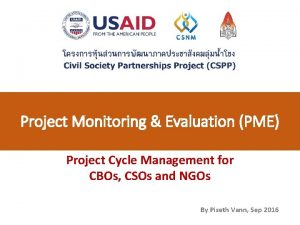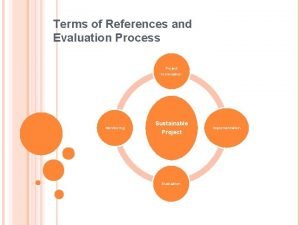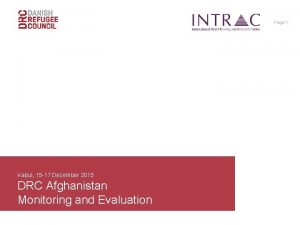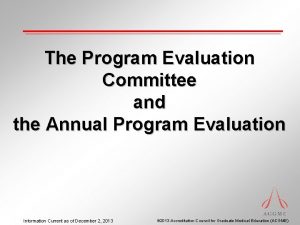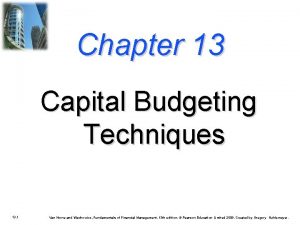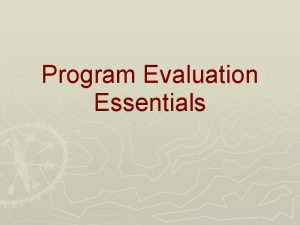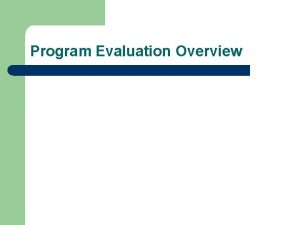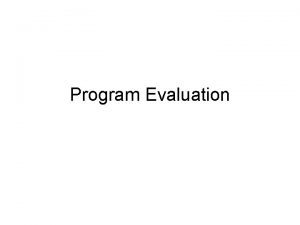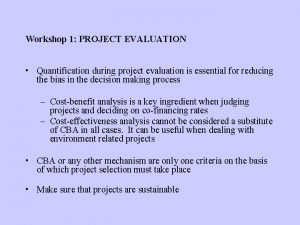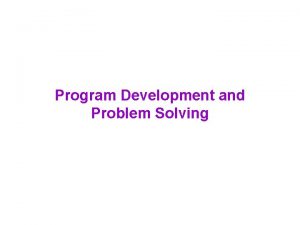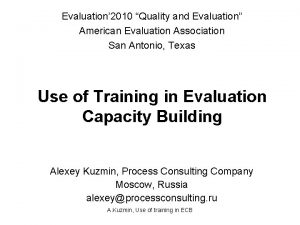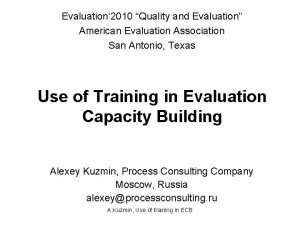PROGRAM PROJECT DEVELOPMENT AND EVALUATION s l e
















- Slides: 16

PROGRAM / PROJECT DEVELOPMENT AND EVALUATION s l e od u l a Ev M n o ati Evaluation and Monitoring Tools / Instruments Fabellar, MAED - Science Claire

Evaluation Model Definition 1 “Evaluation Models either describe what evaluators do or prescribe what they should do” 2 The Evaluation Model is systematic approach that will guide in measuring the efficiency and effectiveness of a training, a course or an educational program

Models of Evaluation Kirkpatrick’s four-level model of evaluation The Stuffle beam CIPP model of Evaluation Flashlight Triad model of evaluation

Kirkpatrick’ Four-Level Model ss According to this. model, evaluation should always begin with level one, and then, as time and budget allows, should move sequentially through levels two, three, and four. Information from each prior level serves as a base for the next level’s evaluation.

Three Reasons for Evaluation Kirkpatrick identifies three reasons to evaluate: v To justify the existence. and budget of the training department by showing how it contributes to the organizational objectives and goals v To decide whether to continue or discontinue training programs, and v To gain informantionon how to improve future training sessions.

Kirkpatrick’s Four-Level Evaluation RESULTS (Level 4) BEHAVIOR (Level 3) LEARNING (Level 2) REACTION (Level 1)

Kirkpatrick’s Four-Level Evaluation Level 4: RESULTS Results evaluation is the effect on the business or environment by the trainee Level 3: BEHAVIOR Behavior evaluation is the extent of applied learning back on the job-implementation Level 2: LEARNING Learning evaluation is the measurement of the increase in knowledge before and after Level 1: REACTION Reaction evaluation is how participant feels about the training or learning experience.

Stufflebeam’ CIPP Evaluation s s Model Context Evaluation Input Evaluation Process Evaluation Product Evaluation

CIPP Evaluation Model MAIN THEME “Evaluation’s most important pupose is not to prove, but to improve”.

Stufflebeam’s CIPP Evaluation Model q CONTEXT is about the environment in which a program would be used. This context analysis is called a needs assessment. q INPUT analysis is about the resources that will be used to develop the program, such as people, funds, space and equipment. q PROCESS evaluation examines the status during the development of the program. q PRODUCT evaluation that assessments on the success of the program.

Stufflebeam’s CIPP Evaluation Model CONTEXT EVALUATION GOALS PLANS INPUT EVALUATION CORE VALUES PRODUCT EVALUATION OUTCOMES ACTIONS PROCESS EVALUATION

Flashlight Triad Model

Flashlight Triad Model The Flashlight Triad Model covers 5 distinctive steps This is basically the brainstorming session where you write down all the aspects of a lesson, a course, a project. Here you are to consider purpose of evaluation. What information do you really want Take the elements you chose in step 2 and create Triads whcih consist of the: Ø Type of technology that is employed (T), Ø The activity the technology enables (A), and Ø Outcomes expected from the activity (O).

Flashlight Triad Model TECHNOLOGY - ü ü Electronic Communications Tools, Email, File Sharing. ACTIVITY - Student Critique of Each Other’s Course Papers, Team-base Projects. OUTCOMES - Increase Student Satisfaction and Collaboration, take Initiatives. From the Triads, now questions are created to gather data about the Triads. These questions usually fall into one of 5 categories: Technology Interaction of Technology and Activity After analyzing gthe data collecting Activity and answering the questions created Interaction of activity and modifications are made.

LIMITATIONS v Kirkpatrick’s four-level model of evaluation: It make an effort to measure the success of the programme from the perspectives of management executives. It actually doesn’t evaluate how the programme relates to the measure of business success. v CIPP Evaluation Model: It is labeled as managerial approach which ignore other stakeholder involve in the process. Reference: www. slideshare. net

Thank You
 Software project evaluation
Software project evaluation Hrd program implementation and evaluation
Hrd program implementation and evaluation Hseep exercise types
Hseep exercise types Forest and range evaluation program
Forest and range evaluation program Project cycle management ngo
Project cycle management ngo Putting it all to bed during project closeout includes
Putting it all to bed during project closeout includes Human factors in project evaluation and control
Human factors in project evaluation and control Project analysis and evaluation
Project analysis and evaluation Types of project evaluation
Types of project evaluation Project formulation and evaluation
Project formulation and evaluation Example of monitoring and evaluation in project proposal
Example of monitoring and evaluation in project proposal What are the objectives of evaluation
What are the objectives of evaluation Program evaluation committee checklist
Program evaluation committee checklist Mixed methods program evaluation
Mixed methods program evaluation Program evaluation
Program evaluation Peer evaluation sample
Peer evaluation sample Pbp formula excel
Pbp formula excel




